Some of the links in this post may be affiliate links.
Rooting and propagating snake plant, or Sansevieria, in water has got to be one of the most fun propagation projects. It is very quick and simple to set up. The hardest part is waiting!
Let’s take a look now at how to water propagate snake plant!
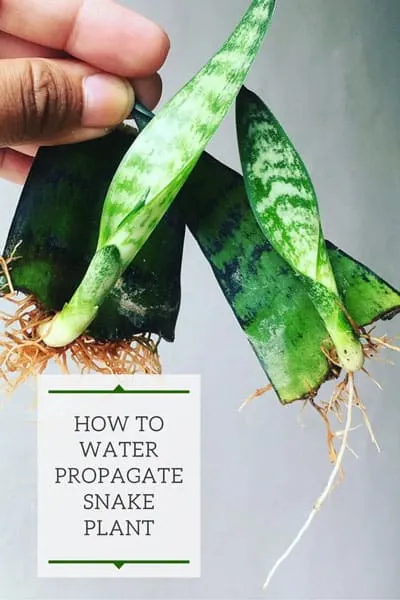
Another common name for this plant is mother-in-law’s tongue. Depending on where you come from, the common name can vary! The genus, Sansevieria, is the botanical name so this is the accepted universal name.
It really is super simple to root Sansevieria in water. The process is as follows:
- Choose a healthy leaf, but not one that is too old.
- Cut the leaf off with a sharp pair of scissors.
- Allow the leaf cuttings to sit for a couple days to let the cut scab or callous over.
- Place in water and wait.
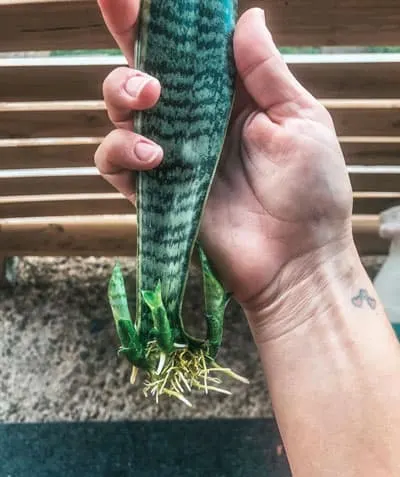
Simple right! Now why do we do all these steps? Let me explain a little more in detail now.
Table of Contents
Choose a Healthy Leaf
Choose a healthy leaf, but not one that is too old. Plants are like people. As we get old, we no longer function like we used to, and are not quite as vigorous 😀
To increase your chances, take a few cuttings if you can!
Cut off the Leaf
Cut the leaf off the plant with sharp, preferably sterilized scissors. You can use a single leaf, or even cut the leaf into sections.
Each section will actually grow baby plants! So from a single leaf, you can get multiple plants.
Aim to have leaf segments that are at least 2-3 inches or so (5-7.5 cm). Or you can use the whole leaf.
Allow the Cuttings to Air Dry
This is not absolutely 100% critical for Sansevieria, but I like to let the cuttings sit for a couple days before placing them in water just in case. I have had success both ways.
This is so that the cuts on the leaf will dry, callous over, and help prevent rotting.
Place in Water and Wait!
This is the hard part! It takes a LONG time to root Sansevieria. However, rooting Sansevieria in water is actually quicker than rooting them in soil. Substantially quicker!
There is one important tip to remember if you decide to cut each leaf into multiple segments.
You must keep the leaf segments in the same orientation as they were growing on the plant.
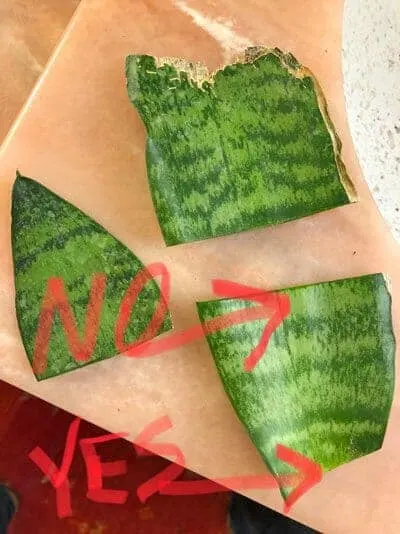
As you can see in the photo above, on the right, you can see that I cut one leaf in half. You can NOT turn the leaf segments upside-down or they will not root.
Place the whole leaves, or leaf segments, in a glass or jar with at least an inch of water or so.
If you use a glass that is narrower at the bottom, it can hold the leaf in place so that the bottom of each leaf doesn’t rest at the bottom of the glass.
You can also use small orchid clips or hair clips to hold the leaves up securely to propagation vessel but so they’re not resting at the bottom on the glass.
This will allow room for the roots to grow. The roots will grow anyway, but this is a little better.
THE SECRET TO SUCCESS
Be sure to change the water frequently. I would start with once or twice a week. If you notice that the water is getting cloudy or dirty, change it more frequently.
Even if you do this, you can still run into issues so here is the real secret to success with water propagation of Sansevieria that no one is talking about!
This is critically important! You may notice especially in the beginning part of the water propagation process that your leaf cuttings will get slimy.
Gross right? Check your cuttings in water often!
Take them out and feel the parts of the leaves that were underwater. If they are slimy, rinse the leaves off under warm or tepid water in the sink and gently rub them with your finger to remove the slime.
Once all your cuttings are clean, you should also clean the container that you have your cuttings in with soapy water. Rinse completely, add the cuttings back in, and add fresh water.
This should greatly diminish the chances of your cuttings from rotting!
Place the rooting cuttings by a window. Bright indirect light, or even a little bit of sun, would be fine. I would avoid placing the cuttings in full sun though, and definitely avoid placing them in the dark.
One last note, if your home uses a water softening system, don’t use this water for your plants! These systems typically place sodium in the water, which is toxic to plants.
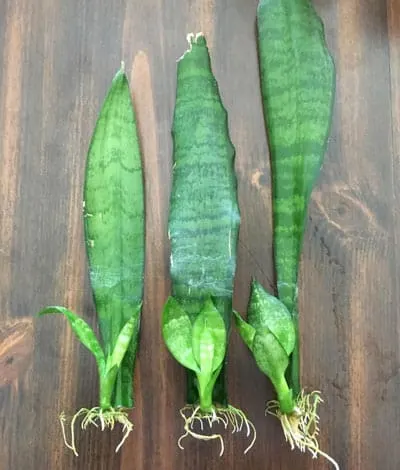
How Long Will The Roots Take to Grow?
Like I mentioned, if you use the water propagation method, it will be MUCH quicker!
From all the people that I’ve communicated with on Instagram, the quickest I’ve heard is 15 days. This is pretty rare and exceptionally fast. These results are not typical.
I would say the average is about 2 months before you’ll see any roots emerging.
Sometimes it takes much longer. (Soil propagation of sansevieria can take several months for roots to form, and even longer for the pups to form.)
After the roots form, you will have to wait a bit longer for the pups to form. The roots will form first, and then perfectly formed little pups will start to grow.
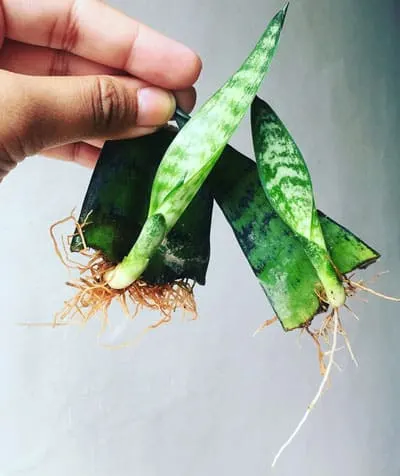
Another tip to remember, is that if you have a variegated plant, the resulting pups that grow from leaf cuttings will NOT be variegated!
Take this beautiful variegated Sansevieria of mine:
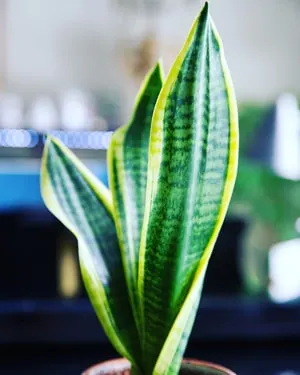
See those beautiful yellow edges? If I were to take leaf cuttings of this snake plant and root them, the resulting pups will not be variegated.
If your goal is to have variegated offspring, you will have to divide the plant itself at the roots, if your plant has multiple crowns, and just split the plant and pot up the individual sections.
Here is one of my own water propagations and it took less than 6 weeks to root, which is pretty good!
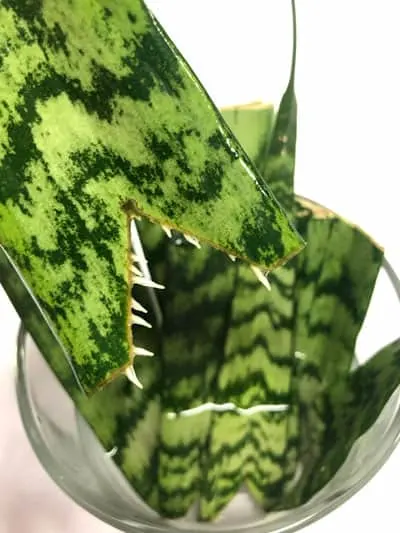
This vessel was placed right in front of an Eastern window so it would get some morning sun.
Take a look at this beautiful pup that grew from one of the leaf cuttings!
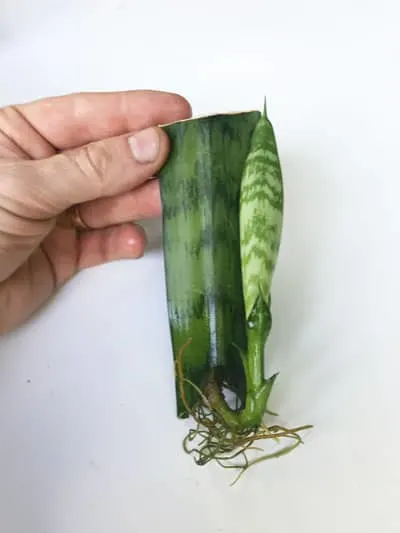
If you are interesting in hydroponically growing your Sansevieria pups, and not plant them in soil, check out my blog post on how to grow snake plants in water permanently.
You CAN grow them permanently in water! In the post I also show you how to separate the pup from the leaf.
Pot Up Your Rooted Sansevieria Cuttings
If you’d rather plant the pups in soil, then follow the procedure below and you use pick wonderful potting mixes from my best soil for snake plants post.
After your leaves have about an inch of roots, you can pot them up into soil. Some people wait until they can see the pups growing, and then pot them up. Honestly, either way is fine.
Here is another rooted Sansevieria (Sansevieria cylindrica) that I rooted in water. This one took a few months and it still doesn’t have pups!
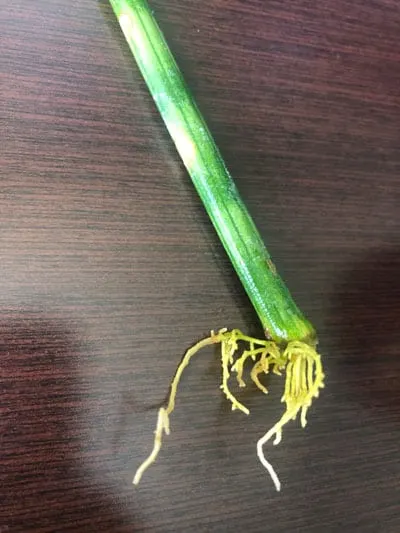
It’s fun to actually see the pups growing in water before you pot them up! Don’t wait too long though if your intention is to grow them in soil. I will probably pot this cutting up before the pups start to form.
They will establish better, but really, either way is just fine.
What kind of soil is good for Sansevieria? Check out my blog post on Sansevieria care where I talk about this topic.
If you’d like to propagate Sansevieria in soil instead of water, be sure to check out my blog post on soil propagation of snake plants. The process is a little different and takes longer, but requires less maintenance.
Be sure not to miss my YouTube video where I discuss snake plant propagation and how to avoid rotting, along with other tips!
If you enjoy water propagation, don’t miss my post on the best houseplants to propagate in water.
FREQUENTLY ASKED QUESTIONS
Do I need to cut a V at the bottom of my snake plant cutting?
Cutting a V at the base of the cutting is not absolutely necessary, but it is very helpful for the following reasons:
- It allows you to tell which end is the bottom of the cutting. The end with the upside-down V will go underwater. Remember, snake plant cuttings can not be turned upside down from how they grew on the mother plant otherwise they won’t grow.
- The V allows for the future pups to have enough room at the bottom of your propagation vessel so they’re not cramped.
- The V allows for more surface area so that you will get more snake plant pups.
How many cuttings can I make from one snake plant leaf?
A lot! The main issue is not making your Sansevieria leaf cuttings too small where they end up falling completely underwater.
As long as you can support them so only the bottom part of the cuttings are underwater, you can make any many cuttings off of a single leaf as you want.
Or if you want to cut a lot of smaller pieces that wouldn’t be able to stand on their own in your vase or jar (or whatever vessel you’re using), you can always gently clip your cuttings to the side of the vessel to secure them so that they don’t fall completely in water.
The more cuttings you can make from a single leaf, the more new pups that you will grow.
How long does it take for snake plant pups to grow?
Typically, your cuttings will start to grow new roots first and then the pups (new baby plant) will grow afterward.
Depending on your growing conditions, you will be waiting a long period of time. Rooting can start to take place in as little as a couple weeks to a couple months or more.
Plan on waiting about 2-4 months before you see any new pups growing. You can shorten the time by placing your propagation vessel on top of a propagation mat that will gently warm the water.
Starting off by choosing healthy leaves to make your cuttings should give you quicker and better results. Don’t use any sickly-looking leaves and leaves that have started to yellow.
Why are my snake plant cuttings rotting in water?
In order to help prevent your snake plant leaf cuttings from rotting, here are some important tips. If you implement all of these tips, you will be able to greatly minimize rotting.
- After you make your cuttings with sharp shears or a sharp knife (make sure you sterilize them with isopropyl alcohol), allow them to air dry for a couple days. Make sure you have a clean cut and the cutting is not frayed. After a couple days, feel the bottom of the cutting. It should feel dry at that point and you can then place the bottom ends of the cuttings in water to start the rooting process. Make sure that the bottom of the cuttings stay below the water level.
- Initially, you will want to change the water very frequently. Change it at least once or twice a week, or more if you notice that the water is getting cloudy. Dirty water will encourage rotting! Fresh water will also introduce more oxygen, which will also helps prevent rotting.
- Rinse and clean your propagation vessel with soap and water to get it squeaky clean.
- Lastly, especially at the beginning of your propagation process, take your cuttings out of the propagation vessel and run them under running water. Use your finger to gently rub the cuttings and remove any slime that has formed on the cuttings.
Water propagation slime. What is it and why is it on my cuttings?
The slime that you feel on your snake plant cuttings (or any cuttings that you are propagating in water), is likely a bacterial slime. This biofilm (even if it’s a beneficial strain of bacteria) can cause your cuttings to rot if enough of it grows on your cuttings.
So be sure to regularly rinse off the slime from your cuttings using running water, while your fingers gently rub the cuttings.
When is the best time to take snake plant cuttings?
The best time to take cuttings is during the growing season when the plant is actively growing and there is plenty of light.
This will greatly speed up and increase your chances of success. Anytime from late water through spring and summer works well.
Avoid taking cuttings in the middle of winter, especially if you live in an area with dark, short days or you will be waiting forever for new growth to occur.
When can I cut the pups off of my snake plant cuttings in water?
I like to wait until the pups have some roots of their own before I snip them off and pot them up in a small pot. Remember that your cuttings will form tiny roots first, and then the pups will grow. The pups will start to grow their own roots too, and you can snip it as I show in the photo below.
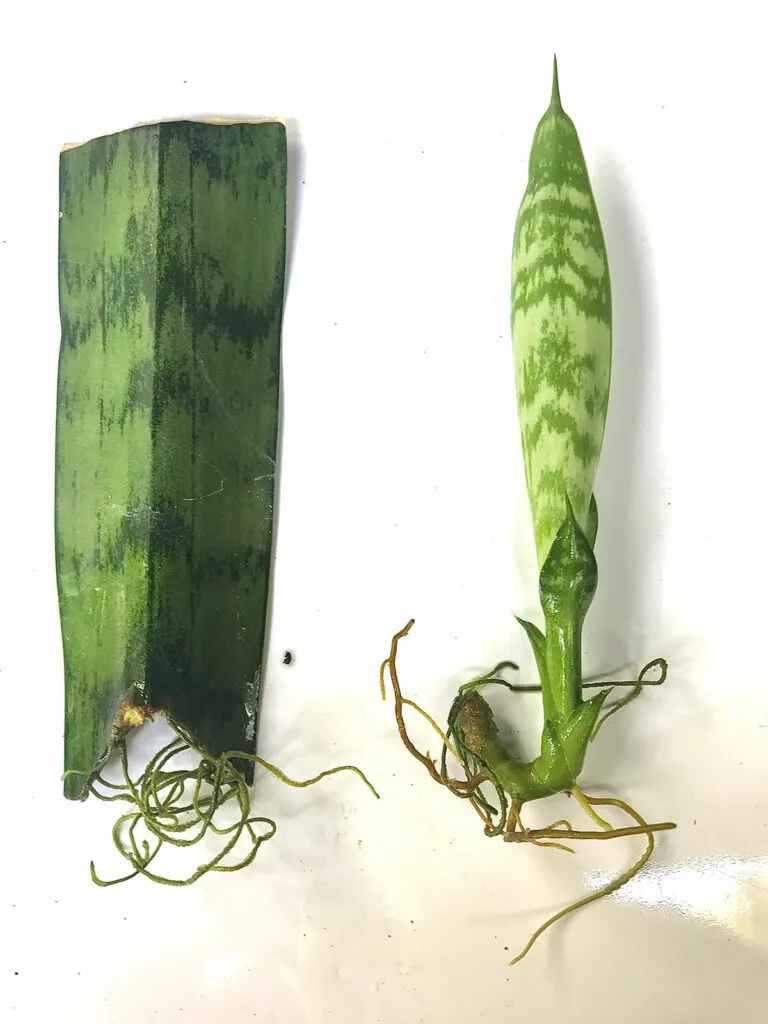
What is the best soil to use for my snake plant pups?
Avoid using plain succulent soil by itself since I find the drainage is not great for many of the commercially available mixes. I like to add some pumice in order to accomplish a more well-draining soil.
If you don’t want to bother mixing your own, I highly recommend the Tropical Succulent Soil Blend from Oh Happy Plants. It can be used straight out of the bag and is wonderful stuff! If you use my link, you will also get 10% off automatically at checkout.
Avoid using a bigger pot for your cuttings. Start out smaller, and then as your plants grow, you can go up a pot size.
I hope you’ve enjoyed this post on water propagation of Dracaena trifasciata (previously known as Sansevieria trifasciata). Although there different methods to propagate your snake plants or mother-in-law’s tongue, water propagation is definitely the most fun to watch!
That’s all folks! Have you tried Sansevieria propagation in water? Keep in mind that there are other ways to propagate snake plants too.


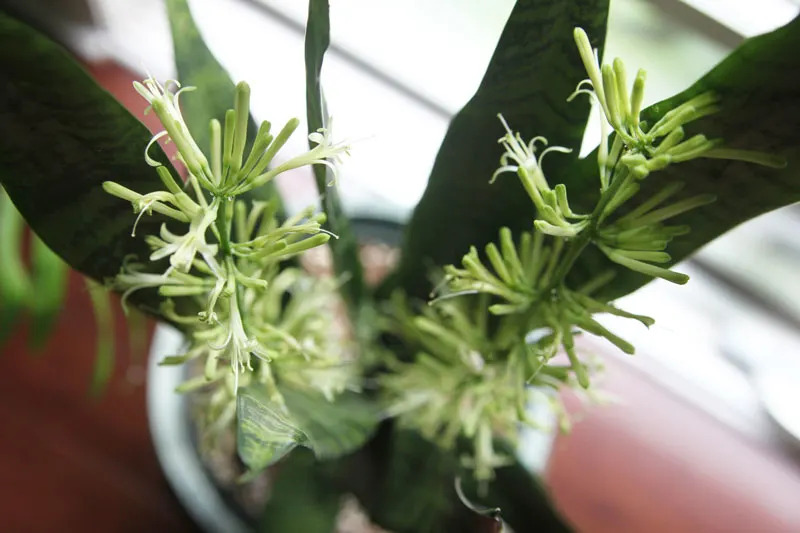
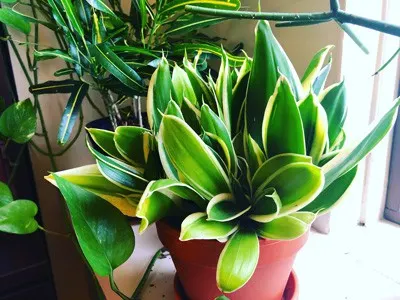
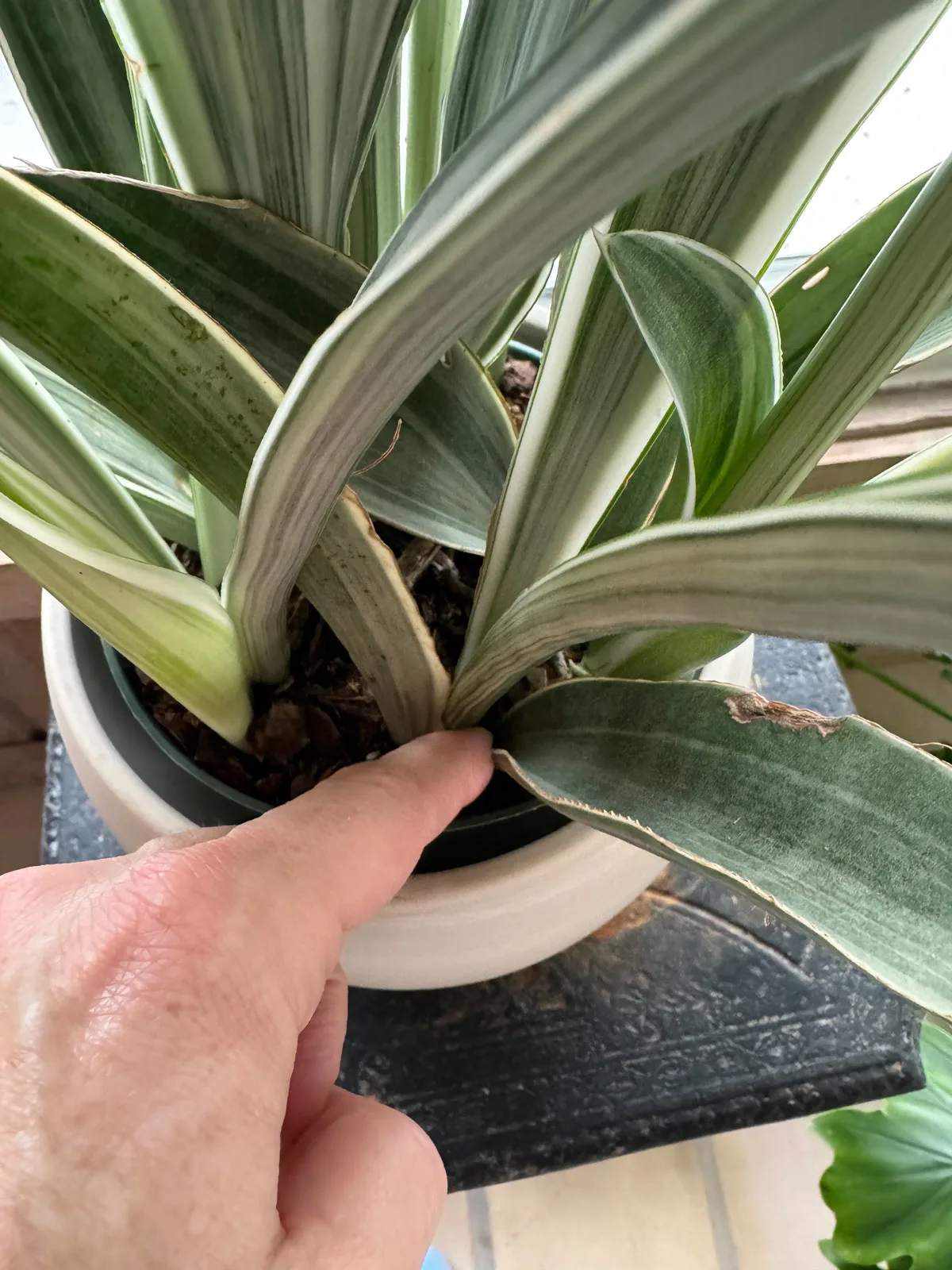
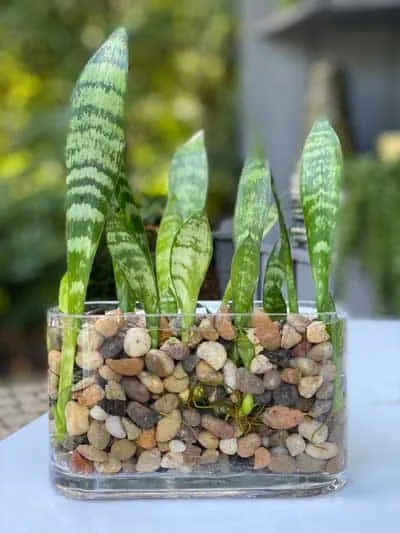
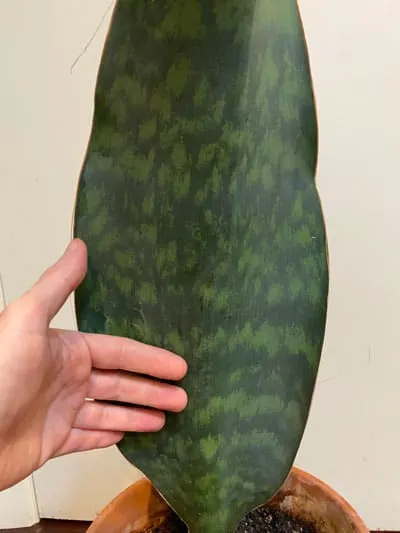
Doriana Rossi
Wednesday 28th of February 2024
Hi, I’ve been growing roots in water for a couple weeks. However, the newest leaf on one of the pups has turned almost completely brown. I chalked it up to going a couple days too long on the water change. After cleaning and rinsing the leaf cutting and pup, and cutting back some of the slimier/ brown roots, I placed back into container with half hydrogen peroxide. Going forward- should I remove this pup leaf? Or let it keep growing?
Raffaele Di Lallo
Wednesday 28th of February 2024
You did the right thing. Just keep the water cleaner and remove anything that has rotted out immediately.
Julie
Saturday 23rd of September 2023
Do you cut a V in the leaf on purpose? And if so, why?
Raffaele
Saturday 23rd of September 2023
Yes, and I do it so there is more surface area for roots and pups to grow.
Ty
Thursday 27th of July 2023
I had used an older leaf since I don't have many large young ones. It's been about two weeks and I can kind of start to see small hairs forming on one but the 3 cut parts are starting turn color and apears to be dying ( color going up the cuttings). 1 leaf cut into 3 parts and in a glass jar, orientated properly. I figure it's because the leaves were too old? Should I keep them in there until its 100 percent dead.?
Raffaele
Saturday 29th of July 2023
Hi Ty! Leave them for now until you're sure they're dying. Just be careful of the water. Change the water very frequently at this stage. Even daily, or anytime you see the water get cloudy or dirty. Good luck!
Alan
Friday 10th of February 2023
Hi Raffaele,
Great page, very informative, thank you!
I have propagated in water, although the pups are now almost the same size as the original leaf. So, a few questions; 1) Is it ok to plant the pups or are they restricted to water now? 2) If I cut off the pups off will the original leaf grow more pups or should I dispose? 3) Is it right that the original leaf will eventually die? 4) is there a way to cross breed?
Thanks for your help :)
Raffaele
Friday 10th of February 2023
Glad you enjoyed the post Alan! 1) You can plant the pups. These plants are very resilient. 2) I've done this, and sometimes the original leaf grows more pups, so it can't hurt to try! 3) The original leaf's purpose is just to grow more pups. You can dispose of it if you cut the pups off, unless you want to wait and see if it grows more pups. 4) Not with leaf cuttings :-)
Adrian Chilembo
Wednesday 2nd of November 2022
This is beautiful. I have some snake plants and l will try the method.
Raffaele
Wednesday 2nd of November 2022
It's very fun! Give it a shot Adrian.